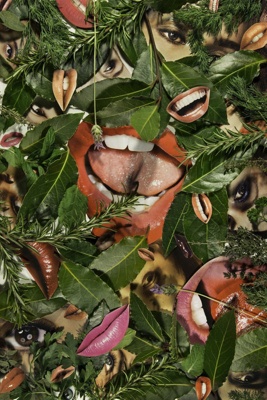Name/TitleFlag: Bower of Bliss
About this objectFlag created as part of Linder Sterling's Bower of Bliss film, which launched the Glasgow International (GI) Festival 2018. The design references Linder's 1976 photomontage, featuring salad from a cookery magazine superimposed with women's eyes and mouths. The flag itself features herbs photographed from the kitchen gardens at Chatsworth House, where Mary, Queen of Scots was imprisoned and Linder spent six months as artist-in-residence. It also references material from GWL's collections, including misogynistic anti-women's suffrage postcards, and a 1970 edition of Oz magazine.
MakerSterling, Linder
Maker RoleArtist
Date Made2018
Period2010s
Medium and MaterialsOrganic, textile
Subject and Association KeywordsGlasgow International Festival of Visual Art (GI)
Subject and Association KeywordsFeminism, feminist movement
Subject and Association Keywordsgender roles & stereotyping
Subject and Association DescriptionOne of the most significant feminist artists of her generation, Linder has created interventions of uncanny glamour and enchantment in Glasgow’s East End. Her site specific works include a spectacular flag commissioned for the Library’s façade, drawing upon the feminist and pop culture artefacts in the Library’s collection. Linder has also created a film work, shot on location at the Mary Queen of Scots Bower, Chatsworth, Derbyshire, where the anointed queen spent some of the fifteen years she was detained under the jurisdiction of Elizabeth I.
http://womenslibrary.org.uk/event/linders-flag-and-film
Linder is known for her photography, radical feminist collage, confrontational performance art, and ties to the British punk scene. One of Linder’s most recognizable works of art first appeared on the sleeve of the 1977 Buzzcocks' single “Orgasm Addict.” On the cover, Linder utilised what would become her signature mass-media collage strategy to adorn or violate—or, really, both—a classical nude female torso with mouths at the nipples and an iron in place of the head. By the time the single was released, Linder had already become a fixture in the Manchester punk and post-punk scene.
In many ways, her collage works from the period have much in common with the subversive practices of punk: Ripping things apart and reassembling them was a way of showing the counterfeit quality and construction of any social image. But Linder’s art went even beyond the rebellion of her underground musical counterparts. Much like Hannah Höch in the Weimar era, Linder fused capitalism, sexuality, violence, feminism, desire, morbidity, and hope in her collages. Linder has transformed herself many times as an artist since those first collages. She performed as the lead singer in the art-punk band Ludus. She’s applied those assemblage tactics to photography and her own portraiture (most recently in a series with flowers).
Paul Hamlyn Foundation Award winning artist Linder has had solo exhibitions at Nottingham Contemporary, Musée d’Art Moderne de la Ville de Paris, Tate St. Ives, and Museum of Modern Art PS1.
Named CollectionGlasgow Women's Library
Object TypeFlag
Object numberGWL-2021-55
Copyright LicenceAll rights reserved


